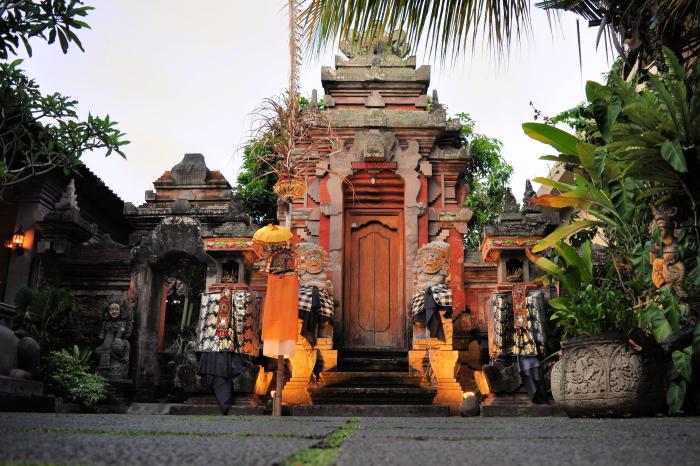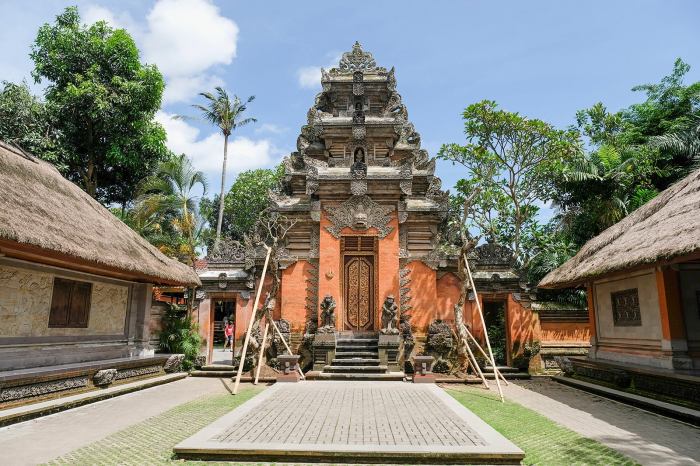Step into the enchanting realm of Ubud Palace, where history, architecture, and culture intertwine to create a captivating tapestry. This royal abode, nestled in the heart of Bali’s cultural hub, offers a glimpse into the island’s rich heritage and vibrant traditions.
Ubud Palace, the official residence of the Ubud royal family, has played a pivotal role in shaping Balinese society for centuries. Its intricate architecture, adorned with symbolic motifs, reflects the island’s artistic prowess and spiritual beliefs.
Historical Significance
Ubud Palace holds immense historical and cultural significance in the heart of Balinese society. Its roots trace back to the 16th century, when it served as the residence of the royal family of Ubud, a prominent kingdom within the Gianyar regency.
The palace has witnessed the ebb and flow of time, bearing witness to the rise and fall of the Ubud kingdom. It stands as a testament to the rich cultural heritage of Bali, showcasing the intricate artistry and traditional architecture that have defined the island for centuries.
The Royal Family
The Ubud royal family, known as the Puri Saren Agung, has played a pivotal role in shaping the cultural and political landscape of Ubud. The family’s lineage can be traced back to the 14th century, with each successive generation contributing to the kingdom’s prosperity and cultural legacy.
The current head of the royal family, Tjokorda Gde Putra Sukawati, is a respected figure in Balinese society. He continues to uphold the traditions of his ancestors while also embracing modernity and fostering cross-cultural exchange.
Influence on Balinese Society
Ubud Palace has exerted a profound influence on Balinese society, particularly in the realm of arts and culture. The royal family has been a patron of traditional dance, music, and painting, nurturing the development of these art forms and ensuring their preservation for future generations.
Moreover, the palace has served as a center for religious ceremonies and festivals, strengthening the bonds of community and reinforcing the spiritual beliefs that are deeply ingrained in Balinese culture.
Architectural Features

Ubud Palace is a stunning architectural masterpiece that embodies the unique traditions and craftsmanship of Balinese culture. Its design blends intricate details with symbolic elements, creating a harmonious and visually captivating space.
The palace complex is composed of several pavilions, courtyards, and gardens, each with its own distinct purpose and significance. The structures are characterized by their traditional Balinese style, featuring intricate carvings, soaring roofs, and colorful embellishments.
Structures and Symbolism
The Bale Kambang, or Floating Pavilion, is a central feature of the palace. It is built on a pond, representing the harmony between water and land. The pavilion is used for important ceremonies and receptions, symbolizing the connection between the palace and the surrounding community.
The Bale Wantilan is a large open pavilion used for gatherings and performances. Its towering roof, supported by massive pillars, represents the strength and stability of the royal family. The intricate carvings on the pillars depict scenes from Balinese mythology, narrating the history and traditions of the Ubud kingdom.
Traditional Craftsmanship
Ubud Palace showcases the exceptional craftsmanship of Balinese artisans. The intricate wood carvings, stone sculptures, and colorful tilework are all testament to the skill and dedication of the craftsmen. The use of natural materials, such as teak wood and volcanic stone, adds to the authenticity and beauty of the palace.
- The carved wooden doors depict scenes from the Ramayana epic, a testament to the palace’s deep connection to Hindu culture.
- The stone sculptures of mythical creatures, such as the garuda and the naga, guard the entrances to the palace, symbolizing protection and prosperity.
- The colorful ceramic tiles, known as genteng, adorn the roofs of the pavilions, adding a vibrant and decorative touch to the architecture.
Tourism and Cultural Experiences
Ubud Palace is a popular tourist attraction in Bali, offering visitors a glimpse into the island’s rich cultural heritage. The palace is open to the public and features guided tours that provide insights into the history, architecture, and significance of the palace.
Cultural Performances and Activities
In addition to guided tours, Ubud Palace also hosts a variety of cultural performances and activities for visitors. These include traditional Balinese dance performances, music concerts, and craft demonstrations. Visitors can also participate in traditional Balinese ceremonies and rituals, such as the Melasti ceremony and the Ngaben cremation ceremony.
Discover the enchanting Ubud Palace, a magnificent architectural masterpiece nestled amidst the lush greenery of Ubud. As you explore its intricate carvings and traditional Balinese architecture, be sure to check out attractions near me to uncover hidden gems and create an unforgettable itinerary that complements your visit to this iconic palace.
Preservation and Promotion of Balinese Culture
Ubud Palace plays a vital role in the preservation and promotion of Balinese culture. The palace is home to a museum that houses a collection of artifacts and relics related to Balinese history and culture. The palace also supports local artisans and craftsmen, providing them with a platform to showcase their work and preserve traditional Balinese crafts.
Surrounding Attractions

The area surrounding Ubud Palace is a treasure trove of cultural and natural attractions that complement the experience of visiting the palace. From sacred temples and lush rice paddies to art galleries and museums, there’s something for everyone to discover.
Ubud Monkey Forest
Just a short walk from Ubud Palace, the Ubud Monkey Forest is home to over 700 Balinese long-tailed macaques. Visitors can stroll through the forest, observe the monkeys in their natural habitat, and learn about their behavior and conservation efforts.
Campuhan Ridge Walk
For a scenic hike, embark on the Campuhan Ridge Walk, which offers breathtaking views of the surrounding rice paddies, hills, and temples. The trail is relatively easy and takes about an hour to complete, making it suitable for all fitness levels.
Ubud Art Market
Art enthusiasts will delight in exploring the Ubud Art Market, where local artisans showcase their handmade crafts, paintings, sculptures, and jewelry. The market is a vibrant hub of creativity and a great place to find unique souvenirs.
Ubud Palace is a popular tourist destination in Bali, known for its beautiful architecture and cultural significance. If you’re looking for a place to do some shopping after exploring the palace, there are several shopping malls nearby where you can find a variety of souvenirs, clothing, and other items.
After your shopping spree, you can head back to Ubud Palace to continue your exploration of this fascinating cultural landmark.
Puri Lukisan Museum
To delve into the rich artistic heritage of Bali, visit the Puri Lukisan Museum, which houses a vast collection of traditional and contemporary Balinese paintings. The museum offers guided tours and workshops, providing insights into the techniques and styles of Balinese art.
Suggested Itinerary
To make the most of your time in Ubud, consider combining a visit to Ubud Palace with some of the surrounding attractions. Here’s a suggested itinerary:* Morning: Explore Ubud Palace and immerse yourself in its history and architecture.
Afternoon
Embark on the Campuhan Ridge Walk for panoramic views and a serene hike.
Evening
Visit the Ubud Monkey Forest to observe the playful macaques and learn about their conservation.By incorporating these surrounding attractions into your itinerary, you can create a well-rounded experience that showcases the cultural and natural wonders of Ubud.
Ubud Palace, the royal palace of Ubud, is a must-see attraction in Bali. The palace complex is surrounded by beautiful gardens and offers a glimpse into the history and culture of Ubud. After exploring the palace, you can head to Kuta Bali , a popular beach destination just a short drive away.
Kuta offers a variety of activities, from surfing and swimming to shopping and nightlife. After a day of exploring Kuta, you can return to Ubud Palace for a relaxing evening stroll through the gardens.
Cultural Events and Ceremonies: Ubud Palace

Ubud Palace is a center for Balinese cultural events and ceremonies. These events are deeply rooted in Balinese traditions and offer visitors a glimpse into the rich cultural heritage of the region.The most important ceremony held at the palace is the Mekare-kare procession, which takes place every 210 days according to the Balinese calendar.
The procession features hundreds of performers dressed in traditional costumes, carrying offerings and performing sacred dances. Other important ceremonies include the Piodalan temple anniversary, which celebrates the founding of the palace, and the Galungan and Kuningan festivals, which mark the victory of good over evil.
Upcoming Events
Visitors to Ubud can check the following calendar for upcoming cultural events and ceremonies at Ubud Palace:
- Mekare-kare procession: March 2023, September 2023
- Piodalan temple anniversary: May 2023
- Galungan festival: June 2023
- Kuningan festival: July 2023
Sustainability and Conservation

Ubud Palace is a testament to the enduring heritage of Balinese culture. As a living monument, its preservation is of utmost importance. Significant efforts have been made to maintain the palace’s integrity and ensure its longevity. Traditional building techniques, utilizing local materials like teakwood and volcanic stone, are employed for restoration and maintenance.
The palace grounds are meticulously landscaped, incorporating sustainable gardening practices that preserve the natural ecosystem.
Balancing Tourism and Cultural Preservation, Ubud palace
Tourism plays a vital role in sustaining Ubud Palace, providing revenue for its upkeep and preservation. However, managing the influx of visitors requires a delicate balance to minimize its impact on the palace’s cultural integrity. Guided tours are carefully regulated to ensure respectful conduct and minimal disruption to ongoing ceremonies.
Visitors are encouraged to dress modestly and observe local customs to preserve the palace’s sacred atmosphere.
Sustainable Practices in Palace Management
Ubud Palace is committed to sustainable practices in its day-to-day operations. Waste management systems are implemented to minimize environmental impact, and efforts are made to reduce energy consumption. The palace grounds are maintained using organic fertilizers and natural pest control methods, preserving the biodiversity of the surrounding ecosystem.
Concluding Remarks
A visit to Ubud Palace is not merely a historical excursion but an immersive cultural experience. Witness traditional dance performances, explore the surrounding attractions, and immerse yourself in the vibrant tapestry of Balinese life. Ubud Palace stands as a testament to the enduring legacy of Bali’s cultural heritage, a treasure to be cherished and preserved for generations to come.
Detailed FAQs
What is the historical significance of Ubud Palace?
Ubud Palace has been the official residence of the Ubud royal family for centuries, playing a pivotal role in shaping Balinese society and preserving local traditions.
What architectural features make Ubud Palace unique?
Ubud Palace showcases a distinctive architectural style that incorporates traditional Balinese craftsmanship and design elements, including intricate carvings, colorful decorations, and symbolic motifs.
What cultural experiences can visitors enjoy at Ubud Palace?
Visitors to Ubud Palace can witness traditional dance performances, participate in cultural workshops, and immerse themselves in the vibrant atmosphere of Balinese life.